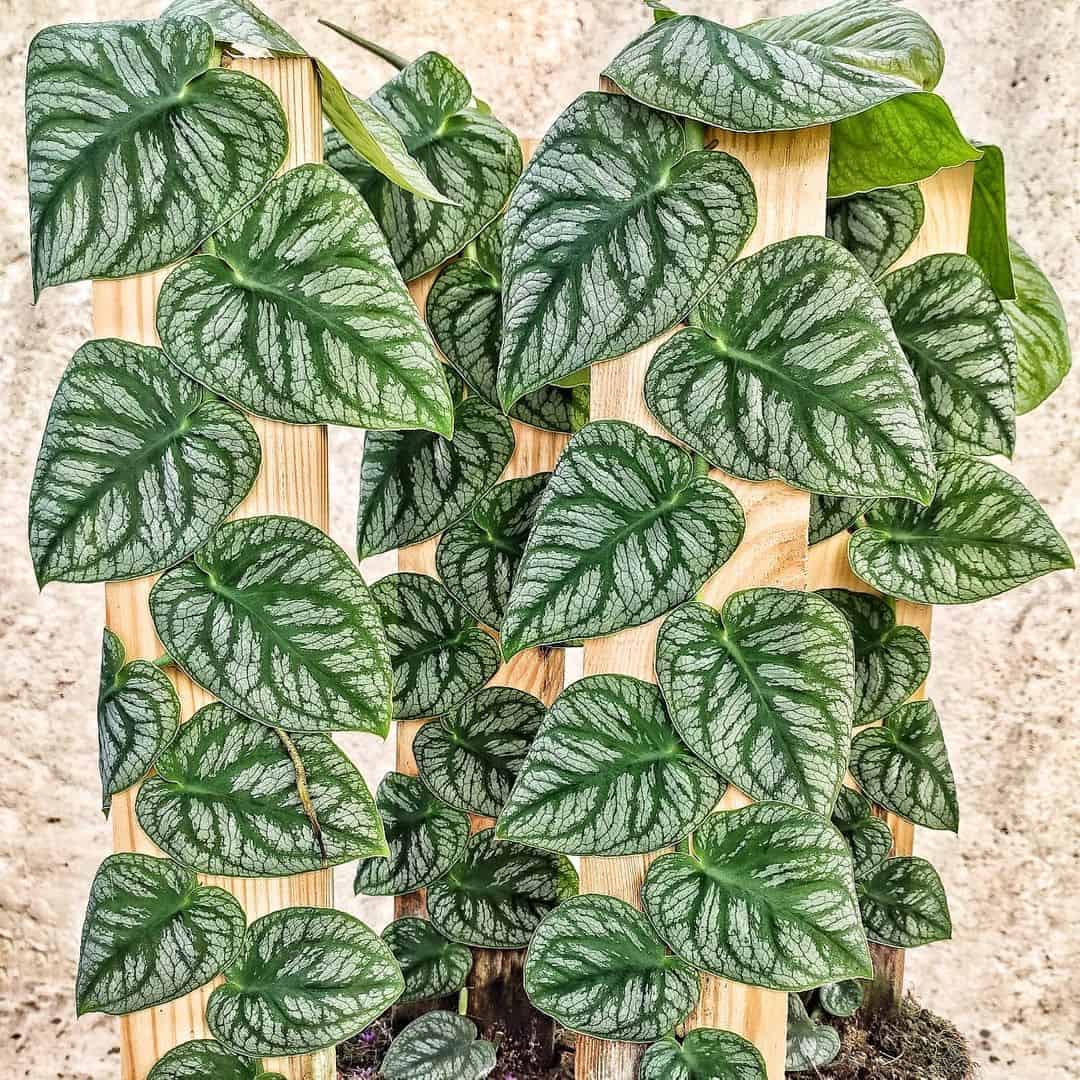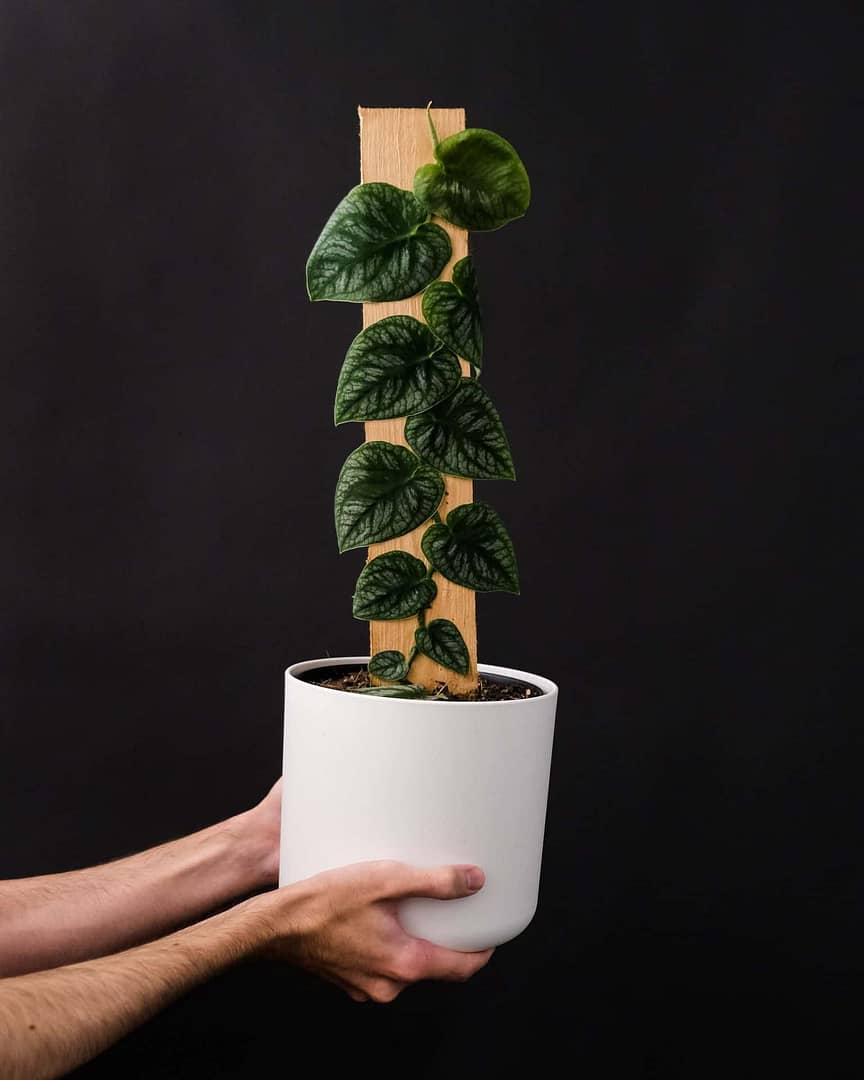About the Monstera dubia
The Monstera dubia is a rare climbing tropical plant from central and south America, with deep green colouration, incredible silver-white variegation patterns, and flat, heart-shaped leaves that fenestrate as they mature.
Also known as the Shingle Plant, this is one of the rarest, but easiest Monstera plants to grow indoors up a moss pole, wooden board, trellis or bare brick wall, and remains relatively small when kept in a small pot. The leaves can grow up to a foot in size if allowed unlimited space to climb and the right conditions.
If you want to add a jungle theme to your home or office, the Monstera dubia is an impressive houseplant specimen that turns heads with its incredibly unique shingle growth pattern and the transformation the leaves take as the plant climbs higher.
This variegated monstera plant is surprisingly easy to grow when given the right conditions with higher than normal humidity, but will quickly outgrow a small climbing frame and will need to be given either an extended surface to vine on, or should be pruned/trimmed at regular intervals.
If this is the plant for you, it is a little difficult to find available online, so check out our buyer’s guide towards the end of this article.
Monstera dubia in the House & Office
Add a touch of the tropical rainforest to your home or office by placing your Monstera dubia plant near a north, east or west-facing window, where it will get bright indirect light, and in a location with more than 50% humidity.
Luckily, this plant is easy to grow in almost any location, but can quickly grow tall if given perfect conditions.
As it grows in a shingle pattern, it will lay flat against a surface and grow straight up, and while a juvenile plant will have small heart-shaped leaves, each subsequent leaf will get larger as the plant grows taller. Only the largest and most mature leaves will fenestrate and show the iconic monstera slits seen in other varieties such as the Monstera deliciosa.
The most common issue you might find with your location is a lack of humidity, which is especially problematic in offices. To prevent this, increase peat moss in the soil mix, group it with other large-leaf tropical plants, mist it daily or weekly, or invest in a humidifier.
Monstera dubia Size
This plant will grow to almost any size depending on how much space you give it. You will need to regularly prune it to the size you need to prevent excessive growth.
Height: Up to 82ft / 2,500cm
Spread: Up to 3ft / 91cm
Monstera dubia Care Guide
Light: The Monstera dubia needs bright indirect light, which is easy to achieve when placed around 5-6 feet from a south-facing window, or closer to others. Keep it away from direct sunlight as this will scorch its leaves and cause your plant to dry out faster.
Soil: Your plant will need soil that retains moisture with plenty of organic matter, but is still well-draining enough to prevent root rot. A potting mix of orchid bark, moss and perlite will keep your plant happy, aerated, and still moist enough to stop it from drying out. You can buy a pre-made aroid soil mix which is perfect for your plant.
Watering: The dubia requires surprisingly relatively little water for a tropical, rainforest plant. You should allow the top 2 inches of soil to dry out between watering, or water once per 1-2 weeks as necessary. If your plant seems unhealthy and the soil is dry, try increasing the water a little.
Humidity: While the plant will thrive best with humidity levels over 50%, the humidity in most homes is usually suitable. If your plant’s leaves look like they are drying out with browning around the edges, you should try increasing the humidity by misting the plant regularly, using a humidifier, grouping the plant together with several others or by placing the pot over a tray of water and pebbles. You can also move the plant to a higher-humidity room such as the bathroom or kitchen.
Feeding: Your plant won’t need to be fed much or often. A small amount of a slow-release fertiliser can be given at a maximum once per month during the spring and summer growing season, but you should start with once every other month for those times of the year.
Temperature: This plant thrives in typical indoor room temperatures, particularly 18-27°C / 64-80°F’. It can certainly survive at lower temperatures but you should ensure that it doesn’t get too cold, and is moved further from cold windows during the winter.
Ailments: Yellow leaves could indicate either over watering, or over feeding, so you should cut back on whichever you are doing most often. Leaf edge burn suggests a lack of humidity so you should do what you can to increase it. Overall leaf browning could suggest that the plant receives too much direct light, so should be moved a little further away from the window.
Growing Surface: A Monstera dubia plank can be made from almost any untreated wood, but the plant will also be happy to grow up a brick wall, moss pole or a typical trellis.
Where To Buy Monstera dubia Online
- Ebay (UK) / (USA)
- Etsy
- Bloombox Club (UK) / (USA)
- Local Facebook Groups
As this is quite a rare plant it may be difficult to find it at most online plant retailers. We recommend heading to Ebay and Etsy where you can choose the exact plant you receive, but you should ensure that wherever you buy from, they have plenty of positive reviews and a reliable return policy.
If your plant arrives damaged, infested with pests, or otherwise unhealthy, you should make sure not to introduce it to your other plants and instead to contact the retailer and request a refund.
FAQs
Why is the Monstera dubia so expensive?
This is a tropical, rainforest plant that is difficult to find even in the wild. It is almost impossible to find in plant shops and garden centres, and most online plant retailers also do not have it available. It is also one of the least-known Monstera varieties.
How can I train my Monstera dubia to climb?
This plant develops aerial roots which latch onto surfaces, but unlike other Monstera varieties these roots are relatively small and may only develop if a node is touching another surface. To encourage the plant to climb, it is as simple as giving it a surface – a wooden board, tree or moss pole – and making sure that the plant physically touches that surface as it grows.

